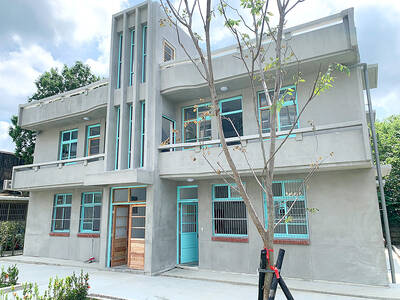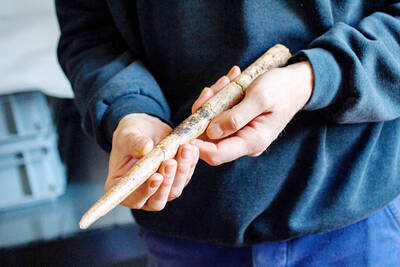Ellen Wu (吳清桂) likes to recall how two fashionable women stopped her during a stroll down New York City’s Fifth Avenue.
“They wanted to know where my outfit was from,” Wu says. “I was so proud!”
But Wu isn’t bragging about her sense of style. Her clothing was sewn from Taiwan floral cloth, the lushly patterned, exuberantly colorful material that conjures up feelings of nostalgia for many Taiwanese. Over the last five years, Wu has made it her mission to establish its place in this country’s cultural history.
Her two best-selling books, Taiwanese Design Treasure Trove (台灣的設計寶庫) and Taiwan Floral Cloth (台灣花布), are the first written about the fabric, which was ubiquitous in the 1960s and 1970s for quilts, curtains and gifts before falling out of fashion. Over the last 10 years, however, Taiwan floral cloth has enjoyed a new life as young designers and artists rediscover the material. Perhaps the best-known is Michael Lin (林明弘), who uses the prints in large-scale installations.
Wu’s own involvement with Taiwan floral cloth began in 2005 when she was asked by the Council for Cultural Affairs (文建會) to organize a fashion show for Taiwan Red (台灣紅), a series of events that promoted taohong (桃紅) as Taiwan’s national color. Taohong literally means “peach red” and is the brilliant fuchsia sprayed on top of shoutao (壽桃), or peach-shaped buns eaten on special occasions. It is also the hue most commonly associated with Taiwan floral cloth. When Wu saw the fabric draped across the stage at a press conference, she was transported back in time.
“I thought it was so beautiful. I lived overseas for a long time and the fabric brought me back to when I was young and we all had quilts made out of huabu (花布),” says Wu, who moved abroad after university and lived in Europe and Canada for 20 years.
Wu’s first book, Taiwanese Design Treasure Trove, was among the 100 best-selling books at Eslite in 2008. In Taiwan Floral Cloth, published last spring, Wu gives detailed descriptions of prints, describes how the cotton fabric is manufactured and traces half a century of its history.
Taiwan floral cloth is variously referred to as red floral cloth (紅花布), grandma cloth (阿媽布) and Hakka cloth (客家布), though Taiwanese of all ages and ethnicities used it in their homes. Yet another name, Far Eastern floral cloth (遠東花布), refers to its best-known maker. In the early 1960s, Far Eastern Textile (遠東紡織公司) and other companies garnered inspiration from Japanese textiles and traditional clothing for their designs — including large bunches of unfurling peonies splashed against bright pink, red or sky blue backgrounds. Peonies represent prosperity and the auspicious prints quickly became popular.
“The climate in Taiwan isn’t suitable for cultivating peonies, so it was rare to see them in real life. They were something Taiwanese people had to imagine. They would imagine how beautiful peony flowers are,” says Wu.
For both books, Wu collected old and new cloth samples from around the country. A bonanza came from a fabric store owner who didn’t seem impressed with Wu’s project, but nonetheless dug up a large binder filled with dusty, decades-old squares of fabric.
“He tossed it to me and said, ‘Fine, here you go, I have no use for this so why don’t you take it?’” Wu says. Back home, she carefully cleaned each sample before it was photographed for Taiwan Floral Cloth. When Wu presented a copy of her book to the storeowner, his reserve melted away.
“His eyes teared up and he asked, ‘How did you make my plain old fabric into something so beautiful?’” Wu recalls.
Wu’s own background is as colorful as the cloth she writes about. Unable to obtain a divorce from Wu’s opium-addicted father, her mother worked several jobs so her three children could receive an education. After graduating from university with a nursing degree, Wu moved to Germany, where she met her husband, Cheng Tzu-tsai (鄭自才), who had fled to Europe after serving time in a US jail for his role in the 1970 assassination attempt on Chiang Ching-kuo (蔣經國). The couple lived in Sweden and Canada for 20 years before returning to Taiwan in the early 1990s. The statue of limitations on attempted murder had expired, but Cheng was arrested for entering the country illegally. During his time in prison, the former architect won the competition to design the 228 Monument in Taipei City’s 228 Peace Park.
In the last two decades since her return to Taiwan, Wu has dedicated herself to social activism. She is the vice director general for the National Organization for Women (中華民國新女性聯合會) and travels internationally as a volunteer with Taiwan Root Medical Peace Corps (台灣路竹醫療和平會).
Wu hopes her books on Taiwan floral cloth will give young people a tangible link to their cultural heritage. It has been half a decade since she became reacquainted with the fabric, but Wu is still smitten. She regularly gives talks on its history, teaches DIY classes and is planning a Kaohsiung exhibition of her oil paintings incorporating the textile for International Women’s Day on March 8.
“I’m very proud of my book because I didn’t study design and I don’t have an academic and research background. But I put a lot of heart into making floral cloth my area of study and I hope it will have a positive impact on Taiwanese culture,” says Wu.

June 2 to June 8 Taiwan’s woodcutters believe that if they see even one speck of red in their cooked rice, no matter how small, an accident is going to happen. Peng Chin-tian (彭錦田) swears that this has proven to be true at every stop during his decades-long career in the logging industry. Along with mining, timber harvesting was once considered the most dangerous profession in Taiwan. Not only were mishaps common during all stages of processing, it was difficult to transport the injured to get medical treatment. Many died during the arduous journey. Peng recounts some of his accidents in

A short walk beneath the dense Amazon canopy, the forest abruptly opens up. Fallen logs are rotting, the trees grow sparser and the temperature rises in places sunlight hits the ground. This is what 24 years of severe drought looks like in the world’s largest rainforest. But this patch of degraded forest, about the size of a soccer field, is a scientific experiment. Launched in 2000 by Brazilian and British scientists, Esecaflor — short for “Forest Drought Study Project” in Portuguese — set out to simulate a future in which the changing climate could deplete the Amazon of rainfall. It is

What does the Taiwan People’s Party (TPP) in the Huang Kuo-chang (黃國昌) era stand for? What sets it apart from their allies, the Chinese Nationalist Party (KMT)? With some shifts in tone and emphasis, the KMT’s stances have not changed significantly since the late 2000s and the era of former president Ma Ying-jeou (馬英九). The Democratic Progressive Party’s (DPP) current platform formed in the mid-2010s under the guidance of Tsai Ing-wen (蔡英文), and current President William Lai (賴清德) campaigned on continuity. Though their ideological stances may be a bit stale, they have the advantage of being broadly understood by the voters.

Artifacts found at archeological sites in France and Spain along the Bay of Biscay shoreline show that humans have been crafting tools from whale bones since more than 20,000 years ago, illustrating anew the resourcefulness of prehistoric people. The tools, primarily hunting implements such as projectile points, were fashioned from the bones of at least five species of large whales, the researchers said. Bones from sperm whales were the most abundant, followed by fin whales, gray whales, right or bowhead whales — two species indistinguishable with the analytical method used in the study — and blue whales. With seafaring capabilities by humans